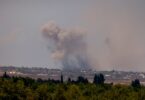Al Mauroni, Zak Kallenborn, Seth Carus & Col. (ret.) Ron Fizer
The last time the US government published a national strategy for countering weapons of mass destruction (WMD), Saddam Hussein was still ruling Iraq, North Korea’s Kim Jong-un was a teenager, and Xi Jinping was governing a Chinese province. The White House and the Kremlin were also talking about “acting as partners and friends in meeting the new challenges of the 21st century.” The world has changed greatly over the past twenty years, and ideally, so should national security strategies.
The December 2002 US government concept for addressing WMD has been completely overtaken by strategic, political, and technological developments, including new risks posed by hypersonic missiles, cyber weapons, drone swarms, pandemic outbreaks, and AI. Today, the United States is threatened by a nuclear North Korea, a potentially nuclear Iran, and an eroding nuclear nonproliferation framework. Am-erican policymakers have witnessed North Korea, Syria, and Russia all use chemical weapons in recent years and have seen concerning biosecurity trends in Russia and China. Due to the nature of modern global supply chains, various state and non-state actors have greater opportunities to procure the materials and equipment needed to develop and deliver WMD.
Despite these threats, there is limited interagency collaboration, and no common approach, within the US government to countering adversaries’ development and use of WMD. Crises, more than deliberate planning, drive the federal government’s actions. WMD pose an acute threat to the United States, but discussions about how to handle them have stagnated, leading to new vulnerabilities to US national security. Today, there is a narrow window to define a new security strategy that builds upon the US government’s past brushes with international incidents, examines new threats, and leverages fresh ideas to improve US foreign policy objectives.
The US government sh-ould, through the National Security Council, formulate a unified strategy that ad-dresses the changing character of, and challenges posed by, WMD. That strategy should align current and future national security capabilities in order to prevent the proliferation of such weapons and discourage adversaries from using them to harm the United States, allied nations, and broader American national security interests. An effective strategy should answer at least three questions: What does the term “weap-ons of mass destruction” m-ean today? How are WMD challenges changing? How should the US government counter WMD? While the authors differ in our precise answers to these questions, we all believe they should be answered to address contemporary security challenges.
What Does the Term ‘Weapons of Mass Destruction’ Mean Today?
In 1948, the United Nat-ions defined “weapons of mass destruction” as “atomic explosive weapons, radi-oactive material weapons, lethal chemical and biological weapons, and any weapons developed in the future which have characteristics comparable in destructive effect to those of the atomic bomb or other weapons mentioned abo-ve.” With the reference to future weapons, delegates of UN members recogniz-ed that new highly destructive weapons could emerge. Over time, the international arms control regimes identified non-lethal chemical and biological weapons (e.g., mustard agent, agent BZ, brucellosis, Q fever) as being “WMD.” Debate continues as to the possible inclusion of certain central nervous system agents and emerging infectious diseases as WMD.
Today, some emerging weapons may also warrant being considered as WMD. An out-of-control cyber weapon, for example, may spread throughout the globe, damaging industrial systems. Nanotechnology aerosols may effectively serve as novel chemical weapons beyond the bounds of existing normative and treaty limitations, and armed, autonomous drone swarms marry mass harm with brittle, easily-fooled AI. Debate is needed on which, if any, of these weapons should be included alongside traditional WMD, and about the degree to which existing non- and counter-proliferation mechanisms are useful in mitigating the risks these new weapons present.
“Weapons of mass destruction,” and variations of the term “chemical, biological, radiological, and nuclear weapons,” do not appear capable of accommodating emerging technology risks. There is also a real debate to be had about whether the term remains useful in describing 21st-century challenges, or whether alternatives or supplements such as “weapons of mass effect,” “weapons of mass agility,” or “weapons of mass disruption” might be more appropriate.
Even without officials and analysts adopting new terms, it’s a problem that the federal government does not have a standardized meaning of WMD. Seth Carus’ exhaustive study found that the US government has adopted 20 separate definitions of the term. For example, the departments of Defense and State focus on a defined list of chemical and biological warfare agents along with nuclear weapons as WMD, while the FBI considers any chemical or biological substance as well as high expl-osives used to harm individuals to be WMD. Definition proliferation is understandable because national security departments, agencies, offices, programs, and projects naturally differ in their focus. However, the cost of idiosyncratic definitions is incoherence in communicating to non-expert stakeholders in civil society, Congress, other members of the federal government, and adversaries that the United States might seek to deter or compel.
Three examples illustrate the definitional challenge and how language may encourage stakeholders to misinterpret policy, strategy, organizational agendas, and threat assessments. Fi-rst, the Justice Department and the FBI talk about WMD threats when individuals or terrorists attempt to acquire ricin — and, often more precisely, a caster bean mash — or improvised explosives. Neither case re-presents a plausible mass c-asualty scenario. This pot-entially confuses Congress and other policymakers as t-o what the US government considers a WMD threat.
Second, former US Ambassador to the United Nations Samantha Power noted in March 2015 that the Syrian government’s use of chlorine bombs was “no less evil than that of chemical weapons,” and the use of chlorine in warfare also clearly falls under the scope of the Chemical We-apons Convention. Yet, the United States did not threaten, or pursue, military acti-on or significant diplomatic efforts to disarm Syria of chlorine, akin to its efforts to disarm Syria of sarin, mustard gas, and other chemical agents. In the future, if US policymakers issue a deterrent or compellent threat on the basis of the terms “weapons of mass destruction” or “chemical weapons,” how will the target of the threat assess American credibility? Based on the lack response to Syrian chlorine use? Or based on the US airstrikes for Syrian sarin use?
Third, the public health and WMD communities clash over the extent to which bioterrorism and natural pandemics should fall under the scope of WMD response. The public health community uses bioterrorism to petition for more resources as compensation for significant cuts in federal and state funding. Meanwhile, the Pentagon’s Chemical-Biological Defense Program, which was established in the late 1990s to address warfare agents, is increasingly funding research related to natural infectious diseases (e.g., Operation Warp Speed). Both cases represent mismanagement of federal funds due to the carefully chosen and ambiguous phrase “biological threats.” Adjudicating such issues at an interagency level would help to resolve the disputes.
How Are WMD Challenges Changing?
Norms against the use of WMD are also threatened. In recent years, some states have used small quantities of chemical agents and radiological isotopes in attacks against domestic political opponents. For example, North Korea’s regime assassinated Kim Jung-nam, the half-brother of Kim Jong-un, with VX, and Russian intelligence officers attempted to kill Sergei and Yulia Skripal using Novichok nerve agents. Bellingcat’s open-source investigations suggest Russia’s chemical and biological weapons programs are much deeper and broader than had been publicly understood. At the same time, global trends such as declining US influence, the rise of authoritarian leaders, and regional tensions are eroding the global nuclear nonproliferation framework.
New technologies are also making it easier for state and non-state actors to acquire, enhance, and use WMD. Today’s biological researchers could use synthetic biology to accelerate the development of biological weapons agents, especially highly-controlled agents like variola virus, and to enhance existing agents through gain-of-function research. Drones are a novel WMD delivery option. When coupled with AI-enabled sensors, drones may increase the targetability of chemical and biological weapons. That could enable the use of smaller amounts of agent and potentially undermine a core rationale for the global norm against them by making it possible to use chemical and biological weapons in a way that discriminates more between civilian and military targets. 3-D printing could potentially allow actors to fabricate the controlled or expensive parts and equipment needed to develop WMD and associated delivery systems. These technologies rely heavily on digital information — 3-D printer build files, AI software, drone control systems — and they are dual-use, rendering traditional nonproliferation tools like interdiction and export controls less effective. Addressing these challenges is likely to require adaptation of counterproliferation concepts.
These technologies were not foreseen when the initial Department of Defense counterproliferation concept was drafted in 2001. The department’s approach was designed to address non-nuclear nation-states seeking chemical and biological weapons for strategic use, as well as to support the federal response to domestic chemical, biological, radiological, and nuc-lear terrorism incidents. An updated concept, based on direction provided in Presi-dential Decision Directive 18 from 1993, needs to ac-commodate the return of gr-eat-power competition and aggressive acts conducted below the threshold of open combat. The military’s offe-nsive counter-WMD capabilities, such as pre-emptive attacks and pathway defeat, are not necessarily useful against nuclear powers such as Russia and China, except maybe to counter vertical proliferation in narrow circumstances.
The US government no longer has one strategy to counter WMD — it has at least three. There is the Defense Department’s strategy to counter such weapons, which includes the traditional mission to protect US forces from adversaries using chemical, biological, radiological, and nuclear weapons on the battlefield. There is a national strategy to counter WMD terrorism. And there is a strategy to defend against and respond to chemical, biological, radiological, and nuclear incidents in the homeland. Within the US government, and even within the Department of Defe-nse, there are multiple concepts and plans to address WMD threats in each of these contexts. Integrating these strategies through a new overarching national strategy may improve unity of effort, identify complementary activities, and create new opportunities for joint activities. For example, any common themes or efforts in the more narrowly defined strategies represent areas where higher-level policy attention or resource allocation can create maximum impact.
How Should the US Government Counter WMD Risks?
The United States should have a guiding strategy to integrate activities aimed at ensuring non- and counter-proliferation of WMD across national security agencies. Such a strategy should recognize the common challenges WMD pose as a class — the need to reinforce international norms, identify and close off proliferation pathways, and punish egregious use of such weapons — but also appreciate the challenges unique to particular classes of weapons, such as the use of chemical weapons in assassination attacks. The guiding strategy should also delineate objectives related to responding to WMD, such as attribution, prosecution, and elimination, across federal agencies, while acknowledging that general response and recovery will be a function of the National Response Framework created in 1992.
American decision-makers should also take a hard look at what lessons the past two decades offer regarding the utility of particular policy levers, including deterrence, compellence, economic sanctions, and diplomatic sanctions. Policymakers should learn lessons from episodes such as the 2003 Iraq War, former President Barack Obama’s attempt to deter Syrian chemical weapons use by setting a “red line,” and former President Donald Trump’s attempts to compel Syria to stop using chemical weapons. Likewise, if any emerging technologies do merit inclusion as WMD, then the United States should identify how policy levers may support counter- and non-proliferation of such technologies.
More broadly, US policymakers should better investigate how policies, strategies, organizations, and specific operational tactics can be adapted to account for the changes emerging technologies create, both individually and in aggregate. While various analyses have explored what individual emerging technologies mean for WMD, virtually none have examined what they mean in aggregate. That’s a problem. The US government should understand how these technologies affect broader proliferation dynamics if it is to appropriately adjust its overall strategy. For example, one major shift is the intermingling of physical and digital systems, which means cybersecurity organizations need to be part of the conversation about WMD.
A unified strategy should also aim to identify the specific roles of agencies — particularly those of the departments of Defense, State, Homeland Security, Health and Human Services, Justice, and Energy — as well as how those roles fit together. In the past few years, the national security bureaucracy has undergone major shifts in how it organizes itself, necessitating a clarification of responsibilities. New organizations have been created, including the Joint Artificial Intelligence Center, the US Army Futures Command, and the proposed State Department Bureau for Cybersecurity and Emerging Technologies. Special Operations Command is now the Department of Defense coordinating authority responsible for assessing counter-WMD awareness and recommending improvements in the plans of other combatant commands. It took over that role from Strategic Command. How each of the various national security organizations supports WMD counter- and non-proliferation should be carefully defined and their responsibilities aligned.
New technologies and aggression below the threshold of open combat — what is now being called “the gray zone” of conflict — represent challenges to the arms control and nonproliferation community’s traditional approach of en-acting incremental changes during treaty reviews that happen every five years. China’s illicit manufacture and shipment of fentanyls to the United States has no clear remedy in US policy. Greater appreciation and preparation is needed within the Defense Department for potential Russian and Chinese use of chemical and biological weapons in regional conflicts, and the State Department has cited both for lack of compliance with arms control agreements. Verification continues to be a wicked problem for biological weapons and associated technologies decades after the Biological and Toxin Weapons Convention entered into force. In no small part, that is due to significant advances in technology such as synthetic biology and the gene-editing tool CRISPR. Perhaps developments in cyber espionage, AI, and biotechnology may create avenues for new approaches to solving these problems. We are doubtful a silver bullet exists, but clearly something has to change.
The US government should also understand what biodefense looks like in a world that is increasingly dealing with significant public health and biosecurity challenges. American policymakers and officials should carefully assess what lessons the response to COVID-19 might offer for bioweapons preparedness and response, including understanding any errors to avoid. Potential areas for lessons learned include hospital preparedness for pandemic response, rapid vaccine development and deployment, and clearly demarcating agency responsibilities in the National Response Framework and other national guidance documents. How should the capabilities of the Department of Defense, Department of Homeland Security, and other major national security agencies support the efforts of more traditional pandemic-response organizations like the Department of Health and Human Services? The concept of “health security” as a feature of national strategy remains underdeveloped, and it deserves an equally in-depth review to one examining how to counter WMD.
Next Steps
National security policy on WMD threats should expand beyond the traditional, technically focused counter-WMD community. By relegating WMD discussions to a few isolated offices, the Department of Defense and other government agencies have failed to integrate this mission into the contemporary strategies, plans, and capability developments necessary to handle future WMD crises. Without the active involvement of the entire national security community in a broad discussion about Secretary Lloyd Austin’s “integrated deterrence” concept and technology developments, the United States will continue to be hobbled by an outmoded WMD definition that only points to solutions that worked during the Cold War. It may be that the term “weapons of mass destruction” should be expanded, supplemented, or just go away. While valuable for the diplomatic community, the term may muddle strategic communication and create bureaucratic misunderstanding. Then again, bureaucratic inertia may mean the term is likely to be retained in its current form. If that is the case, the US government should ensure the term aids, and does not inhibit, national security discussions on current challenges.
The National Security Council should launch a formal process to develop a national WMD strategy to replace the 2002 National Strategy to Combat Weapons of Mass Destruction. That process should include input from academics, nongovernmental organizations, and, of course, traditional national security agencies. As part of developing a strategy, policymakers should carefully consider relevant definitional issues. The overall aim of a National Security Council-led process should be to define what policies and strategies are best suited to limiting the vertical and horizontal proliferation of WMD, given specific security contexts such as major combat operations, irregular warfare, and homeland security.
Additionally, the strategy should clarify how it relates to other complementary strategies and national guidance documents, such as the National Biodefense Stra-tegy and the National Res-ponse Framework. Both of these documents address as-pects that overlap with W-MD non- and counter proliferation and, as such, this revision should also reduce friction and ambiguity between strategies. Insights developed through the strategy development process, as well as the successes (and failures) of the resulting strategy, should inform future strategy development, organizational shifts, and legislative changes as appropriate. Despite the constant turmoil of today’s crises, the Biden administration should take the time to revisit and improve the US approach to the very real threat of weapons of mass destruction.
War On The Rocks






